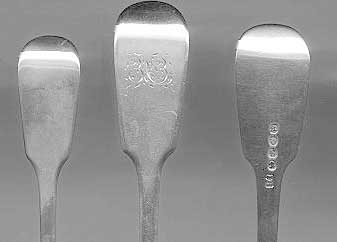|
|
The Collecting Place Settings Forum The forum's posts/subject/threads are closed.
This forum can only be viewed |
|
How to Post Photos
Want to be a Moderator?
|
|
|
The Collecting Place Settings Forum The forum's posts/subject/threads are closed.
This forum can only be viewed |
|
How to Post Photos
Want to be a Moderator?
|

|
 SMP Silver Salon Forums SMP Silver Salon Forums
  Collecting Place Settings Collecting Place Settings
  The Ubiquitous Fiddle (ca 1840) The Ubiquitous Fiddle (ca 1840)
|
| next newest topic | next oldest topic |
| Author | Topic: The Ubiquitous Fiddle (ca 1840) |
|
Bob Schulhof Posts: 194 |
  
The ubiquitous Fiddle  Special Features This American fiddle came to us through England via France where fiddle was the most popular pattern in the mid-eighteenth century. While isolated instances of fiddle can be found in 18th century England the vast majority of it dates after 1800 and by about 1840 it had supplanted Old English as the primary pattern. While the more ornate thread and shell varieties continued in popularity, simple fiddle died out in the early 20th century and is the only British classic pattern not still being produced. Dating Pieces Available (L to R) The $3.00 & $7.00 prices are not typos. The fun of collecting is knowledge and I found these in an antique mall where they were under priced since they didn't say "Sterling" anywhere. I was able to get a couple of each and sold the extras on e-bay for an average 800% profit. The Exeter Dessert fork went to a knowledgeable British collector for $70. Photo: Key Pieces Comments With Old English the tradition was changed as we have here with the spoon bowls facing up and the fork tines down. Hence the handles "turned down" for spoons and "turned up" for forks. According to moderator WEV, this is still the British custom. While early American Coin appears to have followed this British tradition (see Early American Coin Kings on this Forum) somewhere between 1830 and 1850 the States went on our own and have all our bowls and tines facing up. You will note that the above American Spoons are inconsistent, some turned up and some down. I would be interested if anyone can trace the history of this practice of etiquette in the US. IP: Logged |
All times are ET | next newest topic | next oldest topic |
  |
|
Ultimate Bulletin Board 5.46a
|
copyright © 1993-2022
SM Publications
All Rights Reserved. Legal & Privacy Notices |